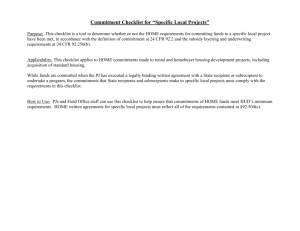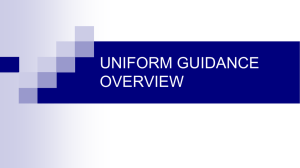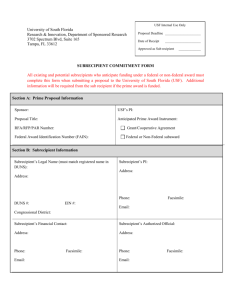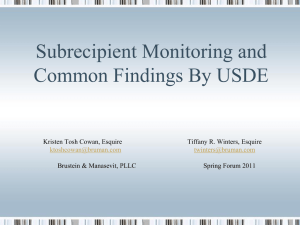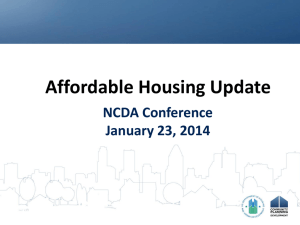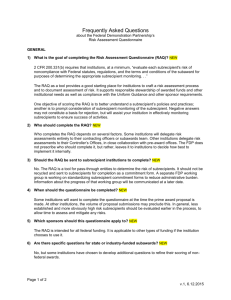Affirmative Fair Housing Marketing Guide
advertisement
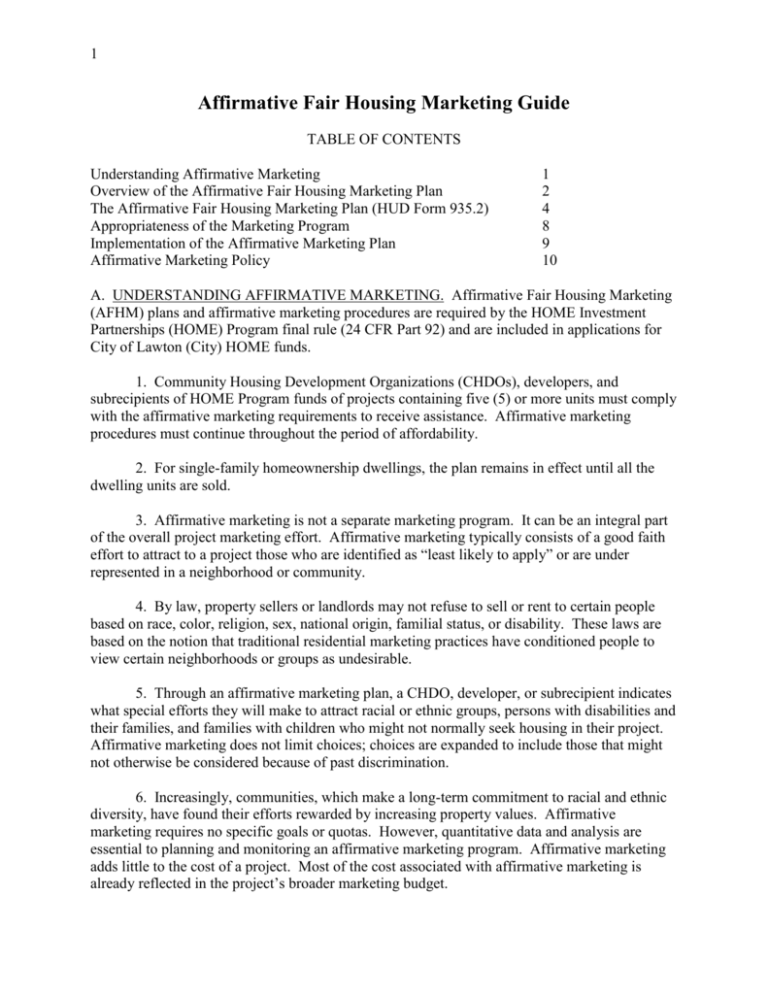
1 Affirmative Fair Housing Marketing Guide TABLE OF CONTENTS Understanding Affirmative Marketing Overview of the Affirmative Fair Housing Marketing Plan The Affirmative Fair Housing Marketing Plan (HUD Form 935.2) Appropriateness of the Marketing Program Implementation of the Affirmative Marketing Plan Affirmative Marketing Policy 1 2 4 8 9 10 A. UNDERSTANDING AFFIRMATIVE MARKETING. Affirmative Fair Housing Marketing (AFHM) plans and affirmative marketing procedures are required by the HOME Investment Partnerships (HOME) Program final rule (24 CFR Part 92) and are included in applications for City of Lawton (City) HOME funds. 1. Community Housing Development Organizations (CHDOs), developers, and subrecipients of HOME Program funds of projects containing five (5) or more units must comply with the affirmative marketing requirements to receive assistance. Affirmative marketing procedures must continue throughout the period of affordability. 2. For single-family homeownership dwellings, the plan remains in effect until all the dwelling units are sold. 3. Affirmative marketing is not a separate marketing program. It can be an integral part of the overall project marketing effort. Affirmative marketing typically consists of a good faith effort to attract to a project those who are identified as “least likely to apply” or are under represented in a neighborhood or community. 4. By law, property sellers or landlords may not refuse to sell or rent to certain people based on race, color, religion, sex, national origin, familial status, or disability. These laws are based on the notion that traditional residential marketing practices have conditioned people to view certain neighborhoods or groups as undesirable. 5. Through an affirmative marketing plan, a CHDO, developer, or subrecipient indicates what special efforts they will make to attract racial or ethnic groups, persons with disabilities and their families, and families with children who might not normally seek housing in their project. Affirmative marketing does not limit choices; choices are expanded to include those that might not otherwise be considered because of past discrimination. 6. Increasingly, communities, which make a long-term commitment to racial and ethnic diversity, have found their efforts rewarded by increasing property values. Affirmative marketing requires no specific goals or quotas. However, quantitative data and analysis are essential to planning and monitoring an affirmative marketing program. Affirmative marketing adds little to the cost of a project. Most of the cost associated with affirmative marketing is already reflected in the project’s broader marketing budget. 2 7. This guide is to assist CHDOs, developers, and subrecipients receiving HOME Program funds; it is not a substitute for obtaining legal advice. It summarizes AFHM plans and affirmative marketing procedures as required by the City. B. OVERVIEW OF THE AFHM PLAN. The AFHM plan is a marketing strategy designed to attract buyers and renters of all majority and minority groups, regardless of sex, handicap and familial status to assisted rental units and sales of dwelling, which are being marketed. In formatting an affirmative marketing program, the CHDO, developer, subrecipient shall do the following: 1. Identify the targeted segments of the eligible population, which are least likely to apply for housing without special outreach efforts; and 2. Outline an outreach program, which includes special measures designed to attract those groups identified as least likely to apply and other efforts designed to attract persons from the total population, and 3. State the indicators to be used to measure the success of the marketing program. The effectiveness of the marketing program can be determined by noting if the program effectively attracted buyers or renters who are: a. from the majority and minority groups, regardless of gender, as represented in the population of the housing market area; and b. persons with disabilities and their families; and c. families with children, if applicable. 4. Demonstrate the capacity to provide training and information on fair housing laws and objectives to sales or rental staff. CHDOs, developers, and subrecipients are required to make a good faith effort to carry out the provisions of their approved plan. Good faith efforts are recorded activities and documented outreach to those individuals identified as least likely to apply. Examples of such efforts include: a. Advertising in print and electronic media that is used and viewed or listened to by those identified as least likely to apply; and b. Marketing housing to specific community, religious or other organizations frequented by those least likely to apply; and c. Developing a brochure or handout that describes facilities to be used by buyers or renters, e.g., transportation services, schools, hospitals, industry, and recreational facilities. The brochure should also describe how the proposed project will be accessible to physically handicapped persons and describe any reasonable accommodations made to persons with disabilities; and 3 d. Insuring that the sales/management staff has read and understood the Fair Housing Act, and the purpose and objectives of the AFHM plan; and e. Developing a referral network with the local fair housing organizations, such as, the City of Lawton and State of Oklahoma Human Rights Commissions. C. THE AFFIRMATIVE FAIR HOUSING MARKETING PLAN (HUD Form 935.2). This form must be filled out completely in accordance with the instruction provided with the form. An authorized official of the CHDOs’, developers’, or subrecipients’ sponsoring organization must sign the form. The form is available at the City’s Housing and Community Development (HCD) or at http://www.hudclips.org/sub_nonhud/cgi/pdfforms/935-2.pdf on the HUD website. 1. The CHDO, developer, or subrecipient should indicate in part 2 of the form whether the plan is to be a project plan or an annual plan for a scattered site builder. a. A project plan is submitted for a particular multifamily project or subdivision located on a single site. b. An annual plan covers all activity to be performed in the ensuing 12-month period. The location and exact number of units are not determined at the time the plan is submitted. In most instances, the annual plan, regardless of type, should cover activities within a single housing market area. A housing market area can be defined in terms of all parts of the City in which the project is located. 2. Scattered (mixed) sites should be grouped and marketed according to the racial and ethnic composition of the census tracts in which they are located. 3. The CHDO, developer, or subrecipient must identify in part 3 of the form the groups that are least likely to apply for housing. For these groups, special outreach is required to inform them of the upcoming housing opportunities. The following are examples of group(s) that might be identified as least likely to apply for the housing in given situations: a. Non-minority persons for a project located in a predominantly minority area; or b. Minority groups for a project located in a non-minority area; or c. Black and non-minorities for a project located in a neighborhood, which is predominantly hispanic. d. If the CHDO, developer, or subrecipient believes that no single group will need special outreach, the CHDO, developer, or subrecipient must indicate in the plan and explain the reasons for such determination. e. In determining which groups may require special outreach, the applicant should consider the following factors: 4 (1) Practices or policies of discrimination such as exclusionary zoning practices; rental, sales, advertising, lending, appraisal, and other practices which may have resulted in discrimination; and (2) Language barriers; and (3) Racial/ethnic composition of defined geographic areas. The CHDO, developer, or subrecipient should consider the following: (a) The neighborhood census tract in which the project is (or will be) located; and (b) The occupancy profiles and waiting list composition of other projects in the market area; and (c) Information on the income eligible population of the housing market area, including racial/ethnic group members, household headed by single persons (gender of household), persons with disabilities, the elderly, families with children and those persons identified as expected to reside in the jurisdiction. 4. In most instances, individuals with disabilities are not likely to apply for the housing without special outreach activities, because such persons may not apply for housing units especially reserved for them without special assistance. The AFHM plan should include resources that have disabled persons of all racial/ethnic groups on lists of potential referrals. Such resources include social service agencies, hospitals, or disabled organizations. The applicant, in planning its outreach activities to disabled persons, should also consider: a. Whether the building is a newly constructed one which must conform to the design provisions of the “Fair Housing Act” and the accessibility provisions of Section 504 of the Rehabilitation Act of 1973; and b. How it plans to explain its policies on permitting reasonable modifications of the unit by the tenant; and c. Its policies with respect to reasonable accommodations in rules, policies, practices and services. 5. The CHDO, developer, or subrecipient must describe the marketing program and outline the methods to be used in marketing to all segments of the eligible population in part 4a of the form. The program must include special outreach steps, which will be taken to attract the groups identified as persons least likely to apply for the housing. a. The CHDO, developer, or subrecipient must indicate the commercial media to be used to advertise the availability of the housing, in particular, the commercial media that are customarily used by the CHDO, developer, or subrecipient, including minority publications, 5 publications targeted toward disabled persons, and other outlets which are available in the housing market area. All advertising should be consistent with the Fair Housing Act regulation at 24 CFR Part 100. The CHDO, developer, or subrecipient should indicate the type of media to be used, including: (1) Newspapers of general circulation; and (2) Radio and/or television stations; and (3) Other types of media including publications of limited circulation such as neighborhood-oriented newspapers, religious publications, and publications of local real estate industry groups. b. For each of the media identified, the CHDO, developer, or subrecipient indicates: (1) Name of the media (e.g., Lawton Constitution, KCCU Radio, KSWO TV); and (2) Type (e.g., classified, display) and size of newspaper advertising and the initial date and frequency of its appearance. Copies of the advertising should be kept on file for future monitoring; and (3) Frequency and length of any radio and/or television advertising; and (4) Identity of the racial/ethnic groups within the audience or readership of the commercial media to be used. c. If the CHDO, developer, or subrecipient does not intend to use commercial media, the plan should indicate the reasons for not using such media. 6. The CHDO, developer, or subrecipient must describe the brochures, signs and the and posters that are an integral parts of any successful affirmative marketing effort marketing in part 4b of the form. a. The CHDO, developer, or subrecipient should consider using brochures as part of the total marketing program. Brochures can be tailored to meet the specific housing needs of those persons who are members of the groups identified as least likely to apply for the housing. The brochure should communicate the CHDO’s, developer’s, or subrecipient’s equal housing opportunity policy. The brochure must be consistent with the fair housing advertising guidelines, including display of the “Equal Housing Opportunity (EHO) logo” and slogan. The brochure should, where appropriate, contain information on the CHDO’s, developer’s, or subrecipient’s policy toward families with children and whether or not the project is reserved as “elderly housing.” 6 b. The CHDO, developer, or subrecipient must indicate the size of any existing or proposed permanent project site sign. The sign must include the EHO logo. A picture of the sign must be placed in the AFHM program file. c. The U.S. Department of Housing and Urban Development’s (HUD’s) fair housing poster must be conspicuously displayed wherever sales/rentals and showings take place. 7. The CHDO, developer, or subrecipient must describe the community contacts, which should be individuals or organizations that have direct and frequent contact with those groups identified in the plan as least likely to apply in part 4c of the form. Examples of suitable community contacts include: a. Fair housing organizations and local nonprofit housing associations, housing counseling agencies, regional tenant referral services; and b. Minority organization, for example, National Association for the Advancement of Colored People (NAACP), Urban League, women’s organizations, civil rights groups, editors of majority owned and minority-owned newspapers; and c. Organizations that advocate for individual with disabilities or address issues relating to the housing needs of such individuals; and d. Organizations that advocate for families with children or address issues relating to housing needs of such families. e. The CHDO, developer, or subrecipient must give the following information about the community contacts: (1) Name of the organization or individual; and (2) Protected class identification of the group or individual; (3) Approximate date the group or individuals are to be contacted. This date should be consistent with the requirements for advance marketing to those persons least likely to apply, where applicable; and (4) Address and telephone number of the person to be contacted; and (5) Methods of contact, e.g., community meetings, brochures, and radio talk shows, and (6) Specific functions the group will perform. f. In order to determine the potential effectiveness of the proposed community contacts, the CHDO, developer, or subrecipient should consider the following questions: 7 (1) Do the community organizations or individuals identified as community contacts have frequent contact with the target groups? (2) Are the functions that the community contacts are expected to perform in implementing the outreach program appropriate to their size and influence in the community? (3) Where applicable, what is the potential effectiveness of the proposed community contacts organizations, which have contact with those persons identified as expected to reside in the community? (4) In cases where organizations or individuals have previously served as community contacts, were these groups or individuals effective as such contacts? 8. The CHDO, developer, or subrecipient must describe in this part 5 of the form the types of activities to be undertaken after the completion of initial occupancy of rental units in order to fill vacancies resulting from normal turnover. a. The CHDO, developer, or subrecipient may undertake the same marketing activities, which were performed during the initial occupancy period or may propose modifications to the plan. b. Some CHDOs, developers, or subrecipients are required to bring their older buildings into compliance with HUD Accessibility Guidelines (24 CFR Part 40) and other programmatic requirements pertaining to accessibility for individuals with disabilities, e.g., Section 504 of the Rehabilitation Act of 1973, as amended. Upon completion of such renovations, the CHDO, developer, or subrecipient should amend the project’s AFHM plan to reflect the undertaking of special outreach activities designed to: (1) Inform individuals with disabilities about the accessible units and about all reasonable accommodations that the CHDO, developer, or subrecipient either has already made or will make for such individuals; and (2) Encourage such persons to apply for those accessible units. The CHDO, developer, or subrecipient must implement a policy of nondiscrimination with respect to families with children and conduct marketing activities intended to attract such families to the project, if it is not exempt from the provisions of the Fair Housing Act pertaining to housing for older persons. 9. The CHDO, developer, or subrecipient must indicate in part 6 of the form whether its staff has had any experience in marketing housing to the groups identified as least likely to apply. The proposed plan should include the following instructions on staff training and experience: a. The CHDO, developer, or subrecipient must indicate the training responsibilities for all employees and agents in writing concerning nondiscrimination in housing. The training should be designed to acquaint participants with the substantive requirements of the Fair 8 Housing Act relating to financing and advertising, expected real estate broker conduct, redlining and zoning practices and discriminatory appraisal practices. The material must also indicate the date established for conducting the training and the name and title of the person responsible for developing the fair housing training program. The training must include the specific civil rights laws and Executive Orders on which sales and management staff should be trained, which are: (1) The Fair Housing Act and 24 CFR Part 100, as well as the HUD complaint processing procedure; and (2) Executive Order 11063 and 24 CFR 200, Subpart M; and (3) City of Lawton Affirmative Fair Housing Marketing Policy; and (4) Any state or local fair housing and equal credit opportunity law and its applicable complaint processing procedure; and (5) Title VI of the Civil Rights Act of 1964, where applicable; and (6) Section 504 of the Rehabilitation Act of 1973, as amended, where applicable, and 24 CFR Part 8; and (7) Civil rights related program requirements relating to AFHM. b. A copy of the instructions and training materials given to staff on fair housing concerns such as federal, state, and local fair housing laws. 10. The form and AFHM plan must be submitted to the City’s HCD office for review and approval when a CHDO, developer, or subrecipient requests funding from the City of Lawton. D. APPROPRIATENESS OF THE MARKETING PROGRAM. The CHDO, developer, or subrecipient should include actions in the marketing program, which are appropriate for attracting the target group(s). The following should be considered: 1. Where African-Americans, Hispanics, Asian-Americans or other racial/ethnic groups have been identified as requiring special outreach, and minority media are available in the housing market area, applicants are encouraged to use minority-owned media as part of their marketing program; and 2. Languages other than English should be used in the advertising where it is necessary to attract target groups, e.g., hispanics; and 3. The advertising should convey an easily understood message that the target groups are welcome in the area in which the proposed project is located. However, the advertising should not imply that the project area is restricted to persons of a particular race, color, creed, sex or 9 national origin, or that families with children and handicapped persons would feel unwelcome; and 4. Both majority and minority models should be used in pictorial advertising and women should be depicted in non-sex-stereotyped roles; and 5. The advertising should convey the message that families with children are encouraged to apply for the housing; and 6. The advertising should feature units that have been made accessible to individuals with disabilities to convey the message that reasonable accommodations can be made so that individuals with disabilities can fully enjoy the project’s services and facilities on the same basis as non-disabled individuals; and 7. The EHO logo should be displayed on all advertising materials. E. IMPLEMENTATION OF THE AFFIRMATIVE MARKETING. The CHDO, developer, or subrecipient should implement a marketing plan for initial sales or rental no later than ninety (90) days prior to the commencement of sales or initial occupancy. The CHDO, developer, or subrecipient should: 1. Prior to initiating general marketing, contact the commercial media, fair housing groups, civil rights organizations, employment centers and the community contacts which have been identified in the plan as resources for attracting persons who are “least likely to apply” for the housing. 2. Establish a system for documenting outreach activities and for maintaining records, which provide racial, ethnic and gender data on all applicants for the proposed housing. The system should be consistent with any reporting and record keeping requirements. It should include all documentation pertaining to: a. How the groups considered least likely to apply were identified; and b. The special outreach activities undertaken to attract these groups and the general public to the housing; and c. The training given to the staff on federal, state and local civil rights laws; and d. The selection of the community contacts who assisted in implementing the AFHM program; and e. Race and ethnicity of all applicants for the housing; and f. Race and ethnicity of all individuals who visited the project in person. 3. The following materials should be kept in the AFHM file for future monitoring: 10 a. Copies of advertisements, brochures, leaflets, and letters to community contacts; and b. Photographs of project signs; and c. Copies of instructions and materials used to train sales/rental staff on fair housing laws. 3. During the 90-day period prior to the commencement of taking applications or sales, provide training to all management or sales staff in federal, state and local fair housing laws, AFHM objectives, and the approved AFHM plan. F. AFFIRMATIVE MARKETING POLICY. CHDOs, developers, and subrecipients receiving HOME Program housing development funds shall adopt policies and procedures that inform the public, potential tenants, and property owners of its affirmative marketing policy. At a minimum the affirmative marketing policy of a CHDO, developer, or subrecipient must: 1. Commit to including the EHO logo in press releases and solicitations for participation in the program; and 2. Have a policy for referrals of housing questions and complaints to its fair housing provider, agency or organization that can provide advice on the state and federal fair housing laws; and 3. At least once annually, conduct a public outreach effort that will make available to the public information on all rental units that have received assistance. Minimally, this information will include the address of the units and the address and phone number of the owner. 4. At a minimum, the affirmative marketing policy will require that owners of projects containing five (5) or more units receiving assistance will comply with the following: a. Prior to sales or rental activity, the CHDO, developer, or subrecipient shall identify at least three (3) groups, organizations, or agencies actively involved with serving lowincome persons who would benefit from special outreach efforts. b. Annually, the CHDO, developer, or subrecipient shall provide these groups with information on assisted units throughout the period of affordability. c. If any units are publicly advertised during the period of affordability, the EHO logo must accompany the advertisement. d. The CHDO, developer, or subrecipient must display the EHO logo and fair housing poster in an area accessible to the public. 11 e. The CHDO, developer, or subrecipient will maintain information on the race, sex and ethnicity of applicants and tenants to demonstrate the results of the CHDO’s, developer’s, or subrecipient’s affirmative marketing efforts. f. The CHDO, developer, or subrecipient will, for the period of affordability, maintain information demonstrating compliance and will make such information available to the U.S. Department of Housing and Urban Development (HUD) and the City of Lawton, upon request. 5. Each CHDO, developer, or subrecipient shall maintain records indicating compliance with the above policies, including: a. Records documenting the CHDO’s, developer’s, or subrecipient’s annual outreach efforts to affirmatively market assisted units, including an annual evaluation of the effectiveness of these efforts. Minimally, this evaluation shall include a discussion with the organizations or agencies identified above, as to the number of referrals made on the basis of the information provided by the CHDO, developer, or subrecipient of assisted units. b. CHDOs, developers, or subrecipients shall maintain monitoring records that indicate the extent to which the CHDO, developer, or subrecipient has complied with the requirements above, and remedies to resolve instances of non-compliance. Edward M. Alexander Federal Housing Programs Coordinator
